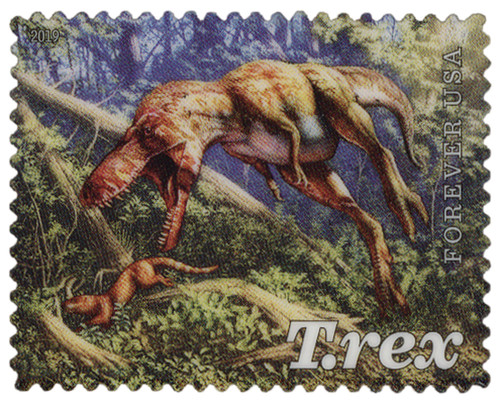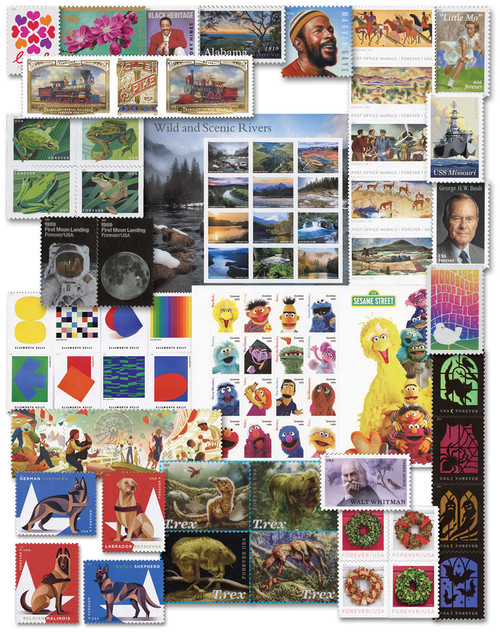
# 5410 - 2019 First-Class Forever Stamp - T. Rex Hatchling
US #5410
2019 T. Rex Hatchling – Tyrannosaurus Rex
- One of four stamps issued to coincide with the opening of a new rex exhibit at the Smithsonian National Museum of Natural History.
Stamp Category: Commemorative
Set: Tyrannosaurus Rex
Value: 55¢ First Class Mail Rate (Forever)
First Day of Issue: August 29, 2019
First Day City: Washington, DC
Quantity Issued: 50,000,000
Printed by: Banknote Corporation of America
Printing Method: Flexographic, Lenticular
Format: Panes of 16
Tagging: Phosphor, block tagged
Why the stamp was issued: To commemorate one of the most famous dinosaurs in history – the Tyrannosaurus Rex.
About the stamp design: Pictures a hatchling Tyrannosaurus Rex paleoartist and scientist Julius T. Csotonyi.
First Day City: The First Day of Issue Ceremony was held at the Smithsonian National Museum of Natural History.
About the Tyrannosaurus Rex set: Includes four stamp designs issued just in time for the opening of the new T. rex exhibit at the Smithsonian National Museum of Natural History. Each design pictures artwork by Julius T. Csotonyi. The stamps showcase a hatchling, juvenile, adult, and fossilized T. rex, showing the entire life cycle of these massive creatures.
History the stamp represents: The Tyrannosaurus rex (T. rex) has long been a creature of interest for the human race. Some Native Americans thought this dinosaur’s fossils were from a legendary creature and would burn the bones in hopes their wishes would be granted. It was not until the 20th century that scientists discovered T. rex and began officially studying it.
Paleontologist Barnum Brown found the first partial specimen of a T. rex in 1900 in eastern Wyoming. Two years later, Brown found a much more complete skeleton in the Hell Creek Formation in Montana. Brown’s discoveries drew other paleontologists to T. rex, and soon the study of this new species exploded.
Through the years, over 50 T. rex skeletons have been found around the world. As paleontologists studied these specimens, new theories were developed and old theories discarded. For example, as late as the 1970s, it was thought T. rex walked upright with its tail on the ground. Scientists eventually realized this would have been impossible for a living animal to achieve, and introduced T. rex’s more horizontal posture.
There are plenty more T. rex secrets paleontologists have yet to discovery. To think, each new fossil dig could hold the answers we have all been waiting for!
US #5410
2019 T. Rex Hatchling – Tyrannosaurus Rex
- One of four stamps issued to coincide with the opening of a new rex exhibit at the Smithsonian National Museum of Natural History.
Stamp Category: Commemorative
Set: Tyrannosaurus Rex
Value: 55¢ First Class Mail Rate (Forever)
First Day of Issue: August 29, 2019
First Day City: Washington, DC
Quantity Issued: 50,000,000
Printed by: Banknote Corporation of America
Printing Method: Flexographic, Lenticular
Format: Panes of 16
Tagging: Phosphor, block tagged
Why the stamp was issued: To commemorate one of the most famous dinosaurs in history – the Tyrannosaurus Rex.
About the stamp design: Pictures a hatchling Tyrannosaurus Rex paleoartist and scientist Julius T. Csotonyi.
First Day City: The First Day of Issue Ceremony was held at the Smithsonian National Museum of Natural History.
About the Tyrannosaurus Rex set: Includes four stamp designs issued just in time for the opening of the new T. rex exhibit at the Smithsonian National Museum of Natural History. Each design pictures artwork by Julius T. Csotonyi. The stamps showcase a hatchling, juvenile, adult, and fossilized T. rex, showing the entire life cycle of these massive creatures.
History the stamp represents: The Tyrannosaurus rex (T. rex) has long been a creature of interest for the human race. Some Native Americans thought this dinosaur’s fossils were from a legendary creature and would burn the bones in hopes their wishes would be granted. It was not until the 20th century that scientists discovered T. rex and began officially studying it.
Paleontologist Barnum Brown found the first partial specimen of a T. rex in 1900 in eastern Wyoming. Two years later, Brown found a much more complete skeleton in the Hell Creek Formation in Montana. Brown’s discoveries drew other paleontologists to T. rex, and soon the study of this new species exploded.
Through the years, over 50 T. rex skeletons have been found around the world. As paleontologists studied these specimens, new theories were developed and old theories discarded. For example, as late as the 1970s, it was thought T. rex walked upright with its tail on the ground. Scientists eventually realized this would have been impossible for a living animal to achieve, and introduced T. rex’s more horizontal posture.
There are plenty more T. rex secrets paleontologists have yet to discovery. To think, each new fossil dig could hold the answers we have all been waiting for!










